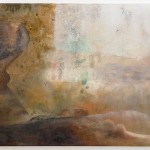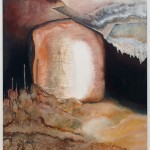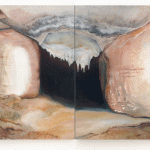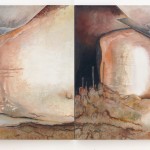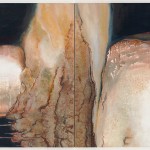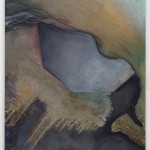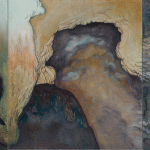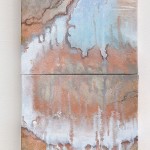Veronika Drahotová
Space Dust Leftovers
Selfscapes: What remains of Veronika Drahotova? What will become of her?
With this selection of new work Veronika Drahotova invites us to join her on a journey, to share in her personal quest and to embark or reflect upon our own. Inspired by the tension between the ostensible concreteness of outer space and the abstraction of inner space she explores the boundaries of experience only to find that experience is also a boundary. The extent to which this boundary both constrains and enables our continued self-fashioning, our becoming as well as our being and belonging, is the puzzle that lies at the heart of these works.
Previously, Drahotova’s work has engaged themes of memory and the persistence of the past in the present. In many ways these new works do the same, but they do so in a more introspective way; they are perhaps the spatial counterparts to the temporalities suggested by her ‘massive memory’ and ‘memplexes’ but they are also personal. They are selfscapes, the landscapes of her own artistic past, the landscapes that she must metaphorically journey through as she questions the value and purpose of her work and its various manifestations and as she seeks renewal and fresh impetus. They are neither the classical landscapes of external, material space, nor the abstract fields of our emotional inner space, but the borderlands where the two meet and become blurred.
Components of previous works endure but are transformed in this show. Modular architectonic canvasses allow for various (re-)arrangements, but their palettes have evolved and, in places they show the artist’s (re-)turn to oils. These material and chromatic snapshots provide evidence of transition or transposition of the past into the present, but they are also laden with traces of the future of technique and composition in gestation. The voids, the absences in these works speak of forgetting but also of the possibility of creation.
Playing with the tensions between depth and surface, past enfacements appear as the ostensibly more familiar terrains of Drahotova’s quest but, like the seeming certainties of the external, material world, this familiarity can be misleading. Past facades are transformed by her conceptual and psychological journey, they are transposed and re-arranged in relation to each other, to the artist and to the audience. Drahotova’s selfscapes suggest that we relate symbiotically to both our surroundings and our pasts, influencing them as they influence us. Their meanings are not fixed but fluid as we interpret them from different perspectives and with differing understandings of ourselves and our place(s) in the world.
Drahotova therefore also asks how we know ourselves and how we know these worlds that we inhabit, as well as how conscious we are of our own actions in them and how much space for manoeuvre we have. The use of abstraction and simplification – in order to better understand our complex worlds replete with their plural pasts and potential futures – resonates in the geometric forms that punctuate and border Drahotova’s work. But meaning shimmers and escapes, revealing the inadequacy of these imposed classifications, of these fixed destinies. Instead, the quest opens.
Drahotova suggests that we must journey into the darkness, the uncertainty that lies at the heart of many of these works, but she also offers us the hope of morning, of the creative possibilities that come from sustained self-reflection if we do not let it paralyse us. This is therefore a heroic journey, but also a quiet one, through her self-scape. It is a journey to which we can all relate to but which will be particular for each of us as we seek to understand what remains and what we will become.
Text: Dr Benjamin Tallis, Institute of International Relations, Prague, Editor-in-Chief, New Perspectives
Veronika Drahotová
Space Dust Leftovers / Zbytky vesmírného prachu
Krajiny sebe sama: Co zbylo z Veroniky Drahotové? A co z ní bude?
Výběrem z nové tvorby nás Veronika Drahotová zve na společnou cestu, během níž se můžeme připojit k jejímu osobnímu hledání či se vydat na cestu vlastní reflexe. Autorka se nechala inspirovat rozporem mezi zdánlivou konkrétností vnějšího prostoru a abstrakcí prostoru vnitřního a při zkoumání hranic zkušenosti zjišťuje, že i zkušenost je jakousi hranicí. Tato hranice omezuje a zároveň umožňuje naše neustálé sebeutváření, stávání se tím, kým jsme, naše bytí a náležení, a právě to, do jaké míry tak činí, je hádankou, v níž spočívá podstata vystavených děl.
Ve své předchozí tvorbě se Drahotová zaobírala tématem paměti a prostupováním minulosti do současnosti. Její nová díla činí mnohdy totéž, avšak s větší mírou introspekce: jako by byla prostorovými ekvivalenty děl zabývajících se časem – vzpomeňme na „Massive Memory“ či „Memplexy“ – zároveň jsou však osobní. Jsou to krajiny sebe sama, krajiny vlastní umělecké minulosti, krajiny, kterými musí umělkyně metaforicky putovat, zkoumat hodnotu a smysl své tvorby a jejích nejrůznějších projevů a nacházet obrodu a čerstvé podněty. Nejsou to klasické krajiny vnějšího, hmotného prostoru, ale ani abstraktní krajiny emocionálního prostoru niterného – jsou to krajiny na pomezí, na rozmlžené hranici mezi dvěma světy.
Výstava opět zahrnuje komponenty známé z dřívějších děl, avšak v proměněné podobě. Modulární architektonická plátna umožňují nejrůznější (pře)nastavení, jejich barevné palety se však vyvíjely a místy ukazují autorčin návrat/obrat k olejům. Tyto materiální a chromatické momentky svědčí o prostupování minulosti do přítomnosti, nesou však rovněž stopy budoucnosti v podobě načrtnutých technik a rodící se kompozice. Tato prázdna, tyto absence v dílech promlouvají o zapomínání, ale rovněž o možnosti tvorby.
Ustupující stopy minulosti pohrávající si s pnutím mezi hloubkou a povrchem se mohou jevit jako důvěrně známé terény autorčina hledání, jejich povědomost však může být stejně zavádějící jako zdánlivé jistoty vnějšího, hmatatelného světa. Masky minulosti se v průběhu konceptuální a psychologické cesty umělkyně proměňují, přesouvají se a přeuspořádávají se vůči sobě navzájem, vůči umělkyni i vůči divákům. Krajiny sebe sama Veroniky Drahotové svědčí o tom, že se symbioticky vztahujeme jak ke svému okolí, tak ke své minulosti, a ovlivňujeme je podobně, jako ony ovlivňují nás. Jejich význam není pevně daný, nýbrž tekutý, podle toho, z kterého pohledu je interpretujeme, jak rozumíme sami sobě a svému místu ve světě.
Drahotová se tedy rovněž ptá, jak dobře známe sami sebe a jak dobře známe světy, které obýváme, a zároveň, jak moc jsme si vědomi svého jednání v nich a kolik manévrovacího prostoru nám zbývá. Práce s abstrakcí a zjednodušením – abychom lépe porozuměli svým složitým světům s jejich zmnoženými minulostmi a možnými budoucnostmi – rezonuje v geometrických tvarech, které díla Veroniky Drahotové prostupují. Samotný význam se však jen zaleskne a zmizí, odkrývaje tak nedostatečnost vnucených klasifikací, pevně daných osudů. Místo toho začíná hledání.
Drahotová naznačuje, že se musíme vnořit do temnoty, do nejistoty, která tkví v samém jádru mnoha jejích děl, zároveň nám však nabízí i naději, že přijde ráno, a s ním i tvůrčí možnosti, které plynou z neustálé sebereflexe, pokud se jí nenecháme paralyzovat. Její cesta je hrdinská a přitom tichá, pozorující krajinu sebe sama. Je to cesta, ke které se můžeme vztáhnout všichni, pro každého z nás však bude jiná, protože se jejím prostřednictvím pokusíme porozumět, co z nás zbylo a co z nás bude.
Autor textu: Dr. Benjamin Tallis, Ústav mezinárodních vztahů v Praze, šéfredaktor časopisu New Perspectives
